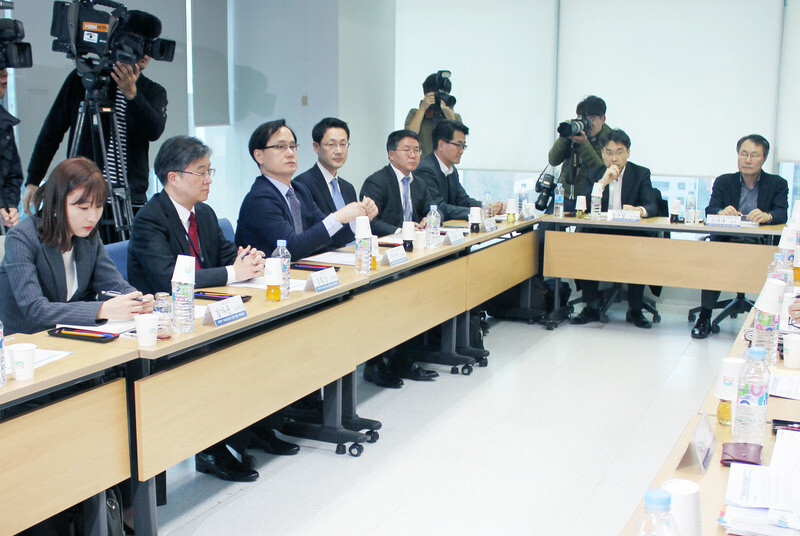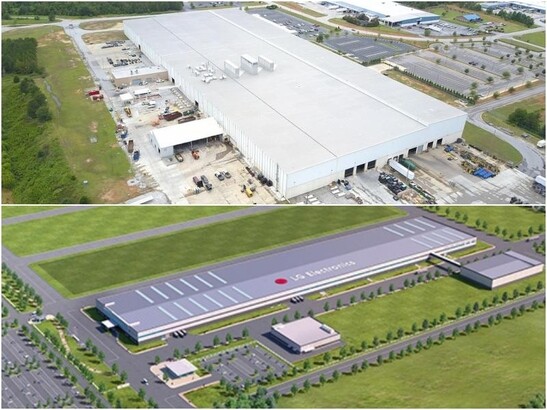hankyoreh
Links to other country sites 다른 나라 사이트 링크
Deadline looms for US decision on washing machine trade safeguards

The US’s aggressive push for trade safeguards on South Korean-made washing machines is intended as a pressure tactic from President Donald Trump to encourage investment by South Korean businesses in local factories and create jobs in the US, analysts are arguing.
With the Feb. 2 deadline looming for Trump’s final decision on safeguard measures against washing machines made by Samsung, LG Electronics, and other South Korean companies, Deputy Minister for Trade Kang Sung-chun told reporters at the Sejong Government Complex on Jan. 15 that the “aim of washing machine safeguards has already been achieved with local factory investment in the US by Samsung Electronics and LG Electronics.”
“Excessive import regulations that go beyond that could deal a severe blow to local factory operations,” he argued.
Kang went on to say he had explained the same position on US washing machine import regulations to US trade officials while visiting Washington, DC, on Jan. 9–11. His position is that the US push for safeguards is intended not just to protect Whirlpool and other US appliance companies by reducing South Korean imports, but also to pressure Samsung and LG into increasing their factory investment in the US.
Most of the large washers exported to the US by Samsung and LG are produced in Thailand and Vietnam. Samsung recently finished construction on a washing machine and appliance factory in South Carolina, which began operating on Jan. 14. LG is also building a washing machine plant in Tennessee, with a target operation date within the year. The message from South Korean authorities appears to be an attempt to counter the Trump administration’s push for safeguards by arguing that South Korean appliance makers have already built factories in the US – and that the safeguards could deal a blow to those factories that may result in US job losses.
“The factories that South Korean appliance makers have built in the US are essentially US corporations,” explained a South Korean trade official.
“The other side of the US’s push for washing machine safeguards is this attempt to pressure South Korean companies into investing more in the US,” the official said.
Kang explained that South Korean officials “have communicated to the US that if safeguards are ultimately unavoidable, they should exempt washers produced and exported within South Korea in accordance with the South Korea-US FTA, and increase the tariff-rate quota for tariff exemptions.”

Trump is expected to make a final decision around mid-February on steel product import regulations according to Section 232 of the Trade Expansion Act, which concerns investigating the security impact of specific steel import items and imposing additional duties or invoking emergency import restrictions on it.
“It has not been confirmed yet whether South Korean steel items are included as import regulation targets,” Kang said.
“We explained to them that because South Korea is a US ally, the steel items that we export do not have a negative impact on US security, and that US concerns about South Korea exporting low-cost Chinese-made items to the US indirectly were based on a misunderstanding,” he added.
“We communicated to them that the percentage of South Korean steel products exported to the US that use Chinese materials is very small, amounting to 2.4% in 2016.”
By Cho Kye-wan, staff reporter
Please direct questions or comments to [english@hani.co.kr]

Editorial・opinion
![[Column] Season 2 of special prosecutor probe may be coming to Korea soon [Column] Season 2 of special prosecutor probe may be coming to Korea soon](https://flexible.img.hani.co.kr/flexible/normal/500/300/imgdb/original/2024/0426/3317141030699447.jpg) [Column] Season 2 of special prosecutor probe may be coming to Korea soon
[Column] Season 2 of special prosecutor probe may be coming to Korea soon![[Column] Park Geun-hye déjà vu in Yoon Suk-yeol [Column] Park Geun-hye déjà vu in Yoon Suk-yeol](https://flexible.img.hani.co.kr/flexible/normal/500/300/imgdb/original/2024/0424/651713945113788.jpg) [Column] Park Geun-hye déjà vu in Yoon Suk-yeol
[Column] Park Geun-hye déjà vu in Yoon Suk-yeol- [Editorial] New weight of N. Korea’s nuclear threats makes dialogue all the more urgent
- [Guest essay] The real reason Korea’s new right wants to dub Rhee a founding father
- [Column] ‘Choson’: Is it time we start referring to N. Korea in its own terms?
- [Editorial] Japan’s rewriting of history with Korea has gone too far
- [Column] The president’s questionable capacity for dialogue
- [Column] Are chaebol firms just pizza pies for families to divvy up as they please?
- [Column] Has Korea, too, crossed the Rubicon on China?
- [Correspondent’s column] In Japan’s alliance with US, echoes of its past alliances with UK
Most viewed articles
- 1Samsung subcontractor worker commits suicide from work stress
- 2Division commander ordered troops to enter raging flood waters before Marine died, survivor says
- 3‘We must say no’: Seoul defense chief on Korean, USFK involvement in hypothetical Taiwan crisis
- 4No good, very bad game for Korea puts it out of Olympics for first time since 1988
- 5[Column] Season 2 of special prosecutor probe may be coming to Korea soon
- 6[Editorial] Korea’s surprise Q1 growth requires objective assessment, not blind fanfare
- 7Korea’s 1.3% growth in Q1 signals ‘textbook’ return to growth, says government
- 8US overtakes China as Korea’s top export market, prompting trade sanction jitters
- 9[Column] Has Korea, too, crossed the Rubicon on China?
- 1046% of cases of violence against women in Korea perpetrated by intimate partner, study finds